Report

1. Asia-Pacific private equity: Record results, gathering clouds
Looking back over the past year, it’s hard to imagine a more perplexing global economic landscape. Oil prices unexpectedly plunged to record lows, global economic expansion slowed, currencies fluctuated wildly—and then there was China. As the growth rate of the world’s second-largest economy fell amid continued export weakness, a staggering $5.1 trillion in wealth evaporated on the Shanghai Stock Exchange between mid-June and the end of August 2015, resulting in deep economic uncertainty about future GDP growth across the Asia-Pacific region and beyond.
Yet amid the growing turbulence, the Asia-Pacific private equity industry posted one of its strongest years on record in 2015 (see Figure 1.1). Deal value spiked to $125 billion, soaring past 2014’s previous record high. Exit activity, at $88 billion, remained robust despite the extreme volatility in the equity markets. Fund-raising was on par with the historical average. And the industry left no doubt about its value to investors: Returns from past investments grew across the region, extending the momentum begun in 2014. Limited partners (LPs) were cash positive for the second year in a row as general partners (GPs) found ways to return capital with improving returns.
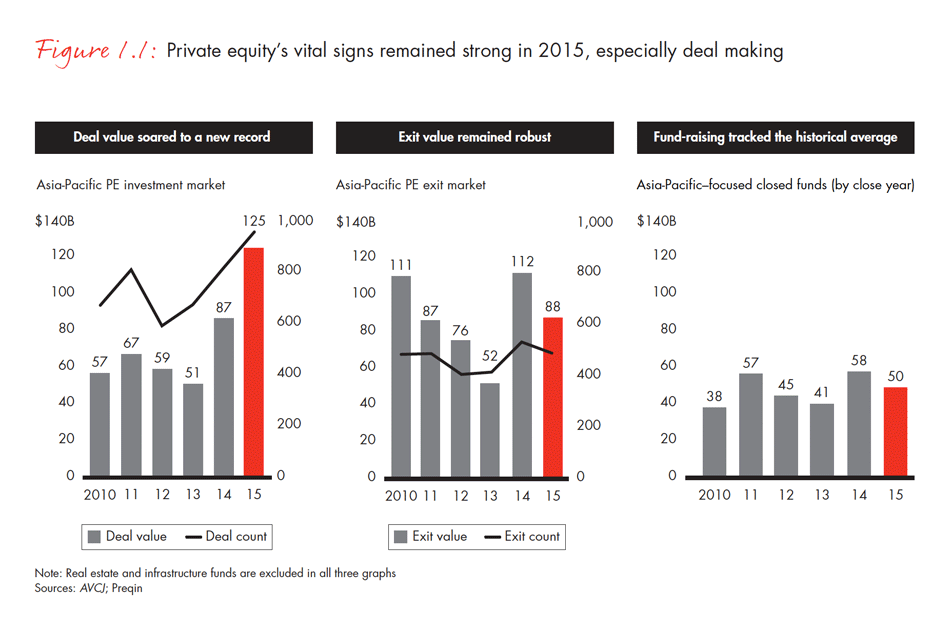
As we emphasized last year, this virtuous cycle of capital invested and capital returned is a critical sign that private equity in the Asia-Pacific region has matured significantly from the overexuberant years between 2005 and 2011. There are other signs of foundational strength as well. Our research indicates that GPs in the region are increasingly winning path-to-control provisions in their deals, enabling a more activist approach to their portfolios. Portfolio dynamics are also improving steadily, even though the industry is laboring under a large overhang of unrealized capital. LPs, meanwhile, continue to flock to the top-returning funds, extending a multiyear flight to quality that is weeding out the underperformers and leaving a clearer field for the winners.
All of this adds up to a much stronger, more resilient industry. But the obvious question is whether the momentum of the past two years can continue. As the macro story deteriorates, the industry is wading into unfamiliar territory—namely, a slower growth environment where it will be much more difficult to find good companies, improve their performance and exit them with market-beating returns. Even a more resilient industry may have trouble grappling with the serious challenges ahead.
For now, PE funds continue to find deals. As equity markets fell in 2015, investors saw massive opportunities in public-to-private transactions such as the China Renaissance–led $7.1 billion buyout of Qihoo 360 Technology. Sovereign wealth funds (SWFs) and other large institutional investors have also remained active in the Asia-Pacific region, giving resourceful GPs the opportunity to participate in a series of megadeals that might not have been available otherwise. At the same time, more company owners, looking to fund growth or to retire, are warming to the PE value proposition, which is increasing the pool of potential investments. And while many traditional industries have languished, the Internet sector has bucked the downturn and continues to present attractive growth prospects.
The problem is that when growth is no longer supported by a rising economic tide, it creates difficulty for PE firms in two ways. First, it puts pressure on existing portfolio companies, many of which funds bought at high prices assuming strong growth. Second, it becomes increasingly difficult to gauge the potential for new companies and invest in them at reasonable prices. Not only do slowing growth and low visibility make it hard to predict future earnings growth but the market remains fiercely competitive, pushing deal multiples higher. Indeed, data shows that despite the meltdown in the equity markets over the past year, average multiples of PE-backed transactions in the Asia-Pacific region rose almost 18%, to 17.8 times enterprise value/EBITDA. Given the market’s headwinds, it’s hard to avoid the conclusion that many investors are buying into a falling market, a trend that may very well put stress on future industry returns.
It’s clear that the market’s turbulence is ushering in a new normal in the Asia-Pacific region characterized by slower growth, new economic drivers and greater regulatory uncertainty. But we also believe PE in the region will continue to draw keen interest from those investors looking for emerging market exposure. Because PE has a longer time horizon than other asset classes and fund managers have more direct control over their investments, the industry has historically outperformed other investment options, especially in times of turbulence. That is not likely to change.
What is different is that investors are no longer willing to trust their capital to any but the most productive funds. The flight to quality that began several years ago has only gained steam amid slowing growth, challenging GPs to rise to a new level of performance. Looking at the top funds in this difficult environment, we find that the winners share three broad characteristics:
- They have stormproofed their portfolios by dialing up their focus on portfolio activism, investing heavily in the people and capabilities needed to maximize the value of their highest-potential companies and generate the most compelling growth stories upon exit.
- They are sourcing from a position of strength by targeting the most resilient sectors, sharpening due diligence to gain the clearest downside perspectives, and devising early, robust strategies for margin improvement, incremental revenue growth and exit planning.
- They are reorganizing internally to devote more talent and resources to fixing companies—in many cases, shoring up turnaround and margin improvement skills. They are also adding depth to investment committee processes by including specialists and others in the portfolio review process while creating stringent guidelines to focus resources where they matter most.
We’ve devoted Section 3 of this report to an examination of some of the key trends that will shape the Asia-Pacific PE landscape in the coming year and beyond. In Section 4, we dig into how the most successful PE firms are investing in the talent, resources and capabilities that will ensure they are ready to thrive amid today’s new normal. More than ever, that means sharpening execution at every phase of the game—finding value at entry, adding value during hold and ensuring a growth story at exit. The Asia-Pacific PE market is still ripe with opportunity. But the winners will be those that take nothing for granted.
2. What happened in 2015?
Despite the macroeconomic uncertainty that began roiling the equity markets by midyear, 2015 in the Asia-Pacific PE industry was all about building on the momentum that began in 2014—a year when deal value hit an all-time high, exits broke out of a dispiriting three-year slump and fund-raising regained steam after two years in decline. Flush with both capital and confidence in 2015, GPs were eager to do deals and found ways to sustain a high level of activity throughout the year even as the broader outlook in China deteriorated. Here is how the year unfolded.
Investments: A year for the record books
Asia-Pacific PE deal value rose a stunning 44% in 2015, to an all-time record of $125 billion—about twice the average of the previous five years. Much of that strength came from an unusual number of very large transactions, but deal activity was robust throughout most of the region (see Figure 2.1). The number of individual transactions rose 34% above the five-year average, to 955, breaking through the 900 mark for the first time. Average deal size also set a new record, expanding to $131 million—45% higher than the five-year average.
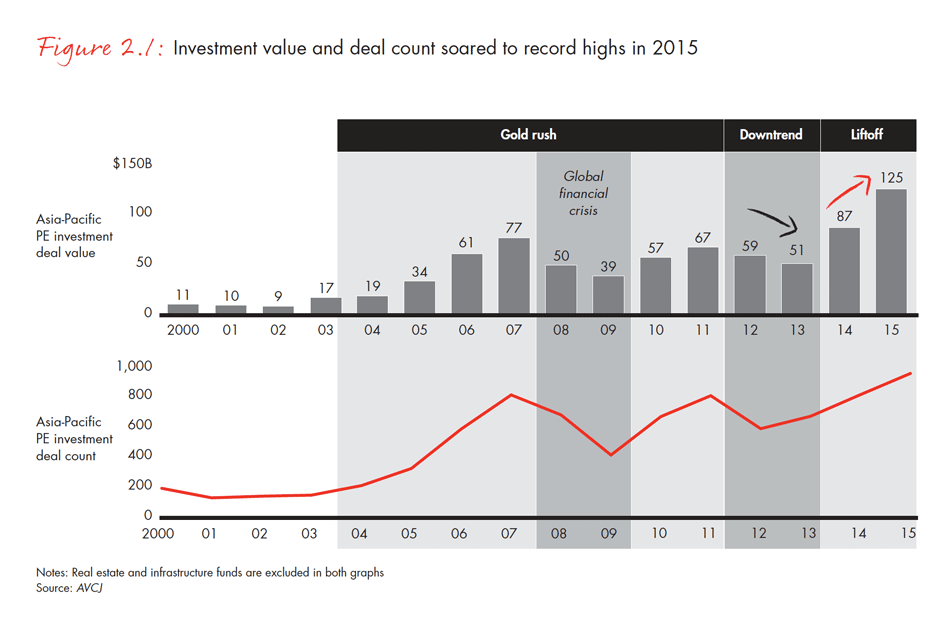
Greater China dominates. For the second year in a row, Greater China (China, Hong Kong and Taiwan) led the charge in both value and deal count. After surging 194% in 2014 (following a worrisome two-year decline), deal value in China grew another 56% last year, to $69 billion, accounting for about half the region’s total. India and South Korea also posted record deal flow while activity ebbed in Southeast Asia and Japan (see Figure 2.2).
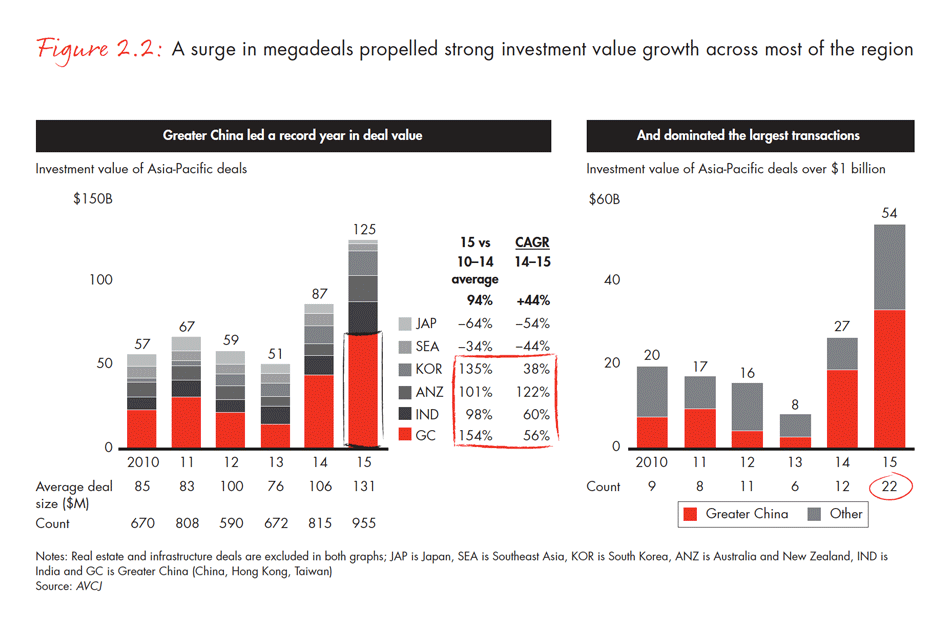
Sheer enthusiasm fueled much of the year’s momentum. Emboldened by a record number of exits, which led to strong fund-raising in 2014, GPs had ample capital to deploy and strong incentive to deploy it. This was especially true in China, where several years of robust fund-raising and lower activity left GPs with a mountain of dry powder. Overall, the Asia-Pacific market had $128 billion in unspent capital in 2015, or about two years’ worth of investment (see Figure 2.3). Opportunity also drew new players to the field. After declining for two years, the number of firms active in the region moved close to 1,400.

A surge in public-to-private deals. Deals larger than $1 billion in value dominated in markets such as China, South Korea and Australia. These megadeals accounted for 43% of total transaction value across the region, almost double the value of a year earlier. Several factors came into play. One was that US investors began to undervalue a number of Chinese companies listed on US exchanges after accounting scandals tarred several of them. That encouraged Chinese owners to seek partners to take many of those companies private in a spate of massive transactions. Public-to-private buyouts soared to $17 billion in value, more than three times the five-year average, and made up 14% of total PE deal value in 2015. The trend spawned three of the top four deals in China—the $7.1 billion Qihoo 360 deal, the $3.1 billion buyout of WuXi PharmaTech led by a consortium of PE funds, and the $3.0 billion buyout of mobile social media company Momo, put together by the company’s CEO, Matrix Partners, Sequoia and Huatai Ruilian Fund Management.
Strong activity among large institutional investors and SWFs also played a role in driving the large crop of megadeals. These massive, government-sponsored investment vehicles have long shown keen interest in the Asia-Pacific PE market, and 2015 was no exception. SWFs and institutional investors coinvested with traditional PE funds in 74 transactions representing $36 billion in value last year. SWFs alone were involved in 10 of the market’s 22 megadeals. As we will discuss more thoroughly in Section 3, direct investment by large institutional investors is an important trend that presents both opportunities and challenges for GPs navigating an increasingly competitive Asia-Pacific landscape. But in our view, these megainvestors tend to expand the market to include deals that most GPs might not have access to or would be reluctant to do on their own.
Internet fever. The Internet sector was by far the hottest area of focus as investors flocked to a narrow set of sectors that promise growth despite the general macroeconomic malaise (see Figure 2.4). As digital technology increasingly defines the daily routine in middle-class China and India, companies offering Internet-based solutions are exploding, generating a tsunami of interest among PE funds looking for growth. Investors across the region piled a record $36 billion into 371 Internet-related deals in 2015 and another $15 billion into 141 technology companies. Media, healthcare and financial services also drew fresh interest in 2015. But other than these five sectors, most industries experienced a decline in deal count as investors focused on playing defense amid highly uncertain conditions.
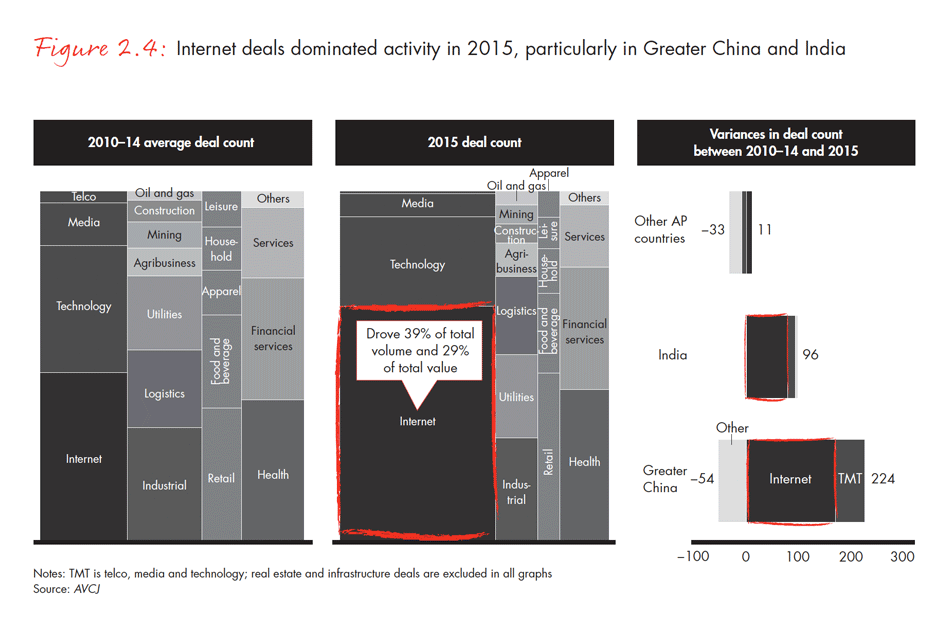
High prices, more control. The searing competition for deals that has long characterized the Asia-Pacific PE market showed no signs of letting up in 2015. Even as asset prices collapsed on the public markets, the scramble to sign deals drove the average multiple of enterprise value in the Asia-Pacific region to 17.8 times EBITDA for PE-backed transactions, well above the average multiple of 10.1 in the US (see Figure 2.5). Such inflated multiples will certainly dial up the pressure on GPs to more actively manage their portfolio companies as they try to squeeze out more value in an uncertain growth environment.

The good news is that they have increasingly found ways to gain more control over their investments. As we mentioned last year, deals with path-to-control provisions are becoming ever more common in the Asia-Pacific region as company owners get more comfortable with the PE value proposition. In 2015, a third of all deals in the region gave investors a stake of more than 50%. Where new investors remained a minority, they were increasingly able to negotiate participation in the most critical decisions related to operating the company. Those provisions will be critical as GPs work with company management teams to execute strategies that create more value.
Exits: Down but still healthy
After soaring to a record $112 billion in 2014, it’s not surprising that exit value backed off in 2015. Perhaps more startling given the volatility in Chinese equity markets is that exits were as strong as they were—especially in Greater China, where initial public offering (IPO) activity slumped badly in the year’s second half amid the equity market collapse (see Figure 2.6). Total exit value across the Asia-Pacific region hit $88 billion, which was in line with the $87 billion five-year average and about even with 2014 if you discount the $25 billion Alibaba IPO that accounted for a major share of that year’s growth. Overall, the market produced 489 individual exit transactions in 2015, slightly more than the historical average.
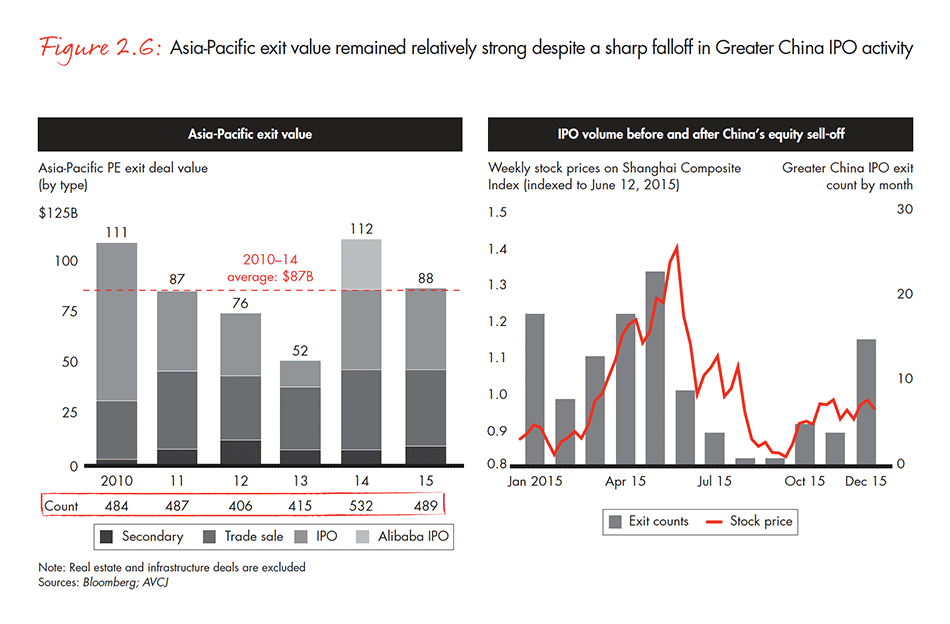
Strength in China and India. Greater China drove more than half the exit value in the region, largely on the back of several massive IPOs, most of which were completed before the Shanghai market fell apart in June. India’s market for exits, on the other hand, benefited from a strong uplift in its public equity market and strong macro conditions throughout the year. As the total number of exit transactions in India grew sharply, exit value expanded to $12 billion, more than twice the five-year average.
Overall, IPOs accounted for $40 billion in total exit value, and trade sales (those with a strategic acquirer) delivered another $38 billion. Secondary exits (asset sales between PE firms) remained a relatively small channel but grew slightly to $10 billion in 2015. Most GPs expect secondary deals to expand as an exit channel since both sides of the transaction see benefits—for sellers, a straight sale is more expeditious than an IPO, and buyers get a company that another PE firm has already vetted.
Portfolio cleanup. Although exit value was not as strong as in 2014, the data contained clear positives. The relatively robust exit activity two years in a row has helped GPs keep their promises to LPs by returning more capital. It also helped GPs scrub their portfolios of old deals by either swallowing or selling companies bought at high valuations before the 2008 global financial crisis. Pre-2008 vintages now make up only 36% of unrealized value, down from 64% two years ago. Looking at buyout deals by investment year, the percentage of pre-2008 companies was 17% in June 2015, about half the global average (see Figure 2.7).
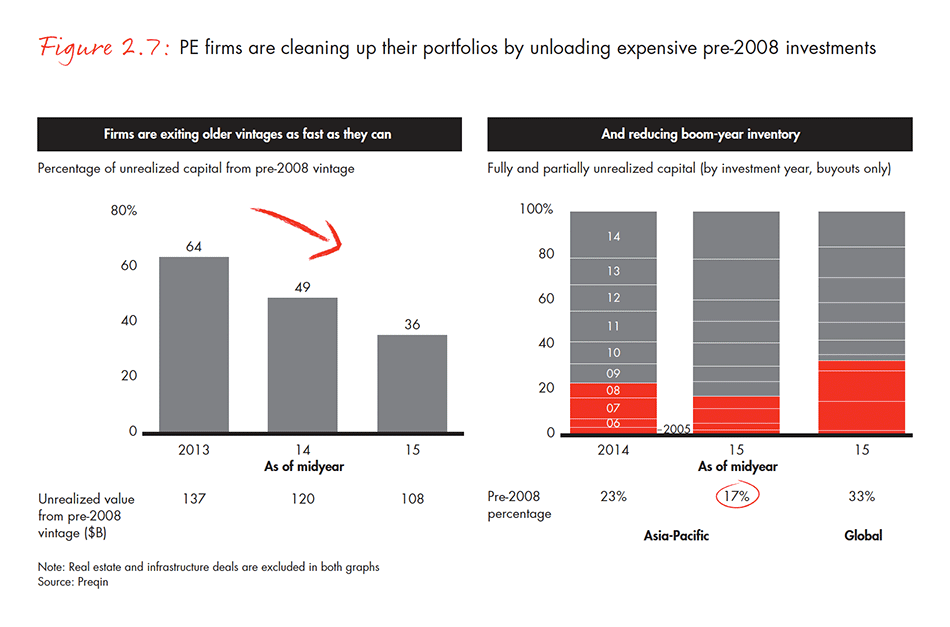
The amount of unrealized capital held in Asia-Pacific–focused PE funds grew by 23% between June 2014 and June 2015, to reach the $300 billion mark for the first time. An expansion in this exit overhang can be a sign that the industry isn’t recycling capital fast enough. But in this case, the increase was generated by the record level of new deals, which is producing younger portfolios on average. That and the industry’s efforts to clean out older deals actually trimmed the average holding period for Asia-Pacific PE assets to 4.4 years from 4.8 years a year earlier (see Figure 2.8).
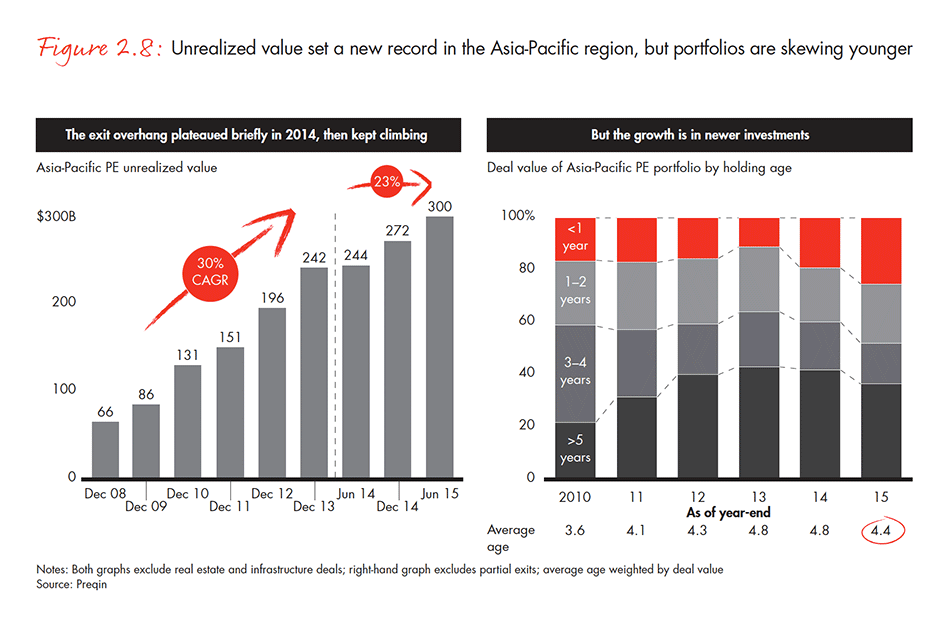
Hurdles ahead. All of that is good news, but there are still reasons for concern. With heavy competition driving company valuations higher, it will be increasingly difficult for GPs to exit companies at the returns they were hoping for when they made the investments. The ongoing volatility in the equity markets promises to make the IPO channel difficult—much as it was in China during the second half of last year. And as economic growth slows, it will put downward pressure on company earnings, making it harder to position portfolio companies for strong exit multiples. The industry’s challenge amid such conditions will be to keep the exit overhang from growing as older investments begin to pile up again. For GPs under pressure to keep the investment flywheel turning, the message is clear: As competition for deals drives up average multiples, it will be critical to stay disciplined when making acquisitions and focus on exit strategies from day one.
Returns: Sustained momentum—for now
When it comes to returns, the challenge for GPs in the years ahead will be to keep up the hard-won positive momentum of the past two years. As we’ve mentioned, 2014 was the first year in the industry’s history that LPs were cash positive, meaning aggregate distributions of capital were higher than capital calls. If you were to include real estate and infrastructure funds, the turning point would actually have come in 2013. The most recent available numbers indicate that the trend continued last year. Through the first half of 2015, LPs got about $1.30 back for each $1 called (see Figure 2.9).
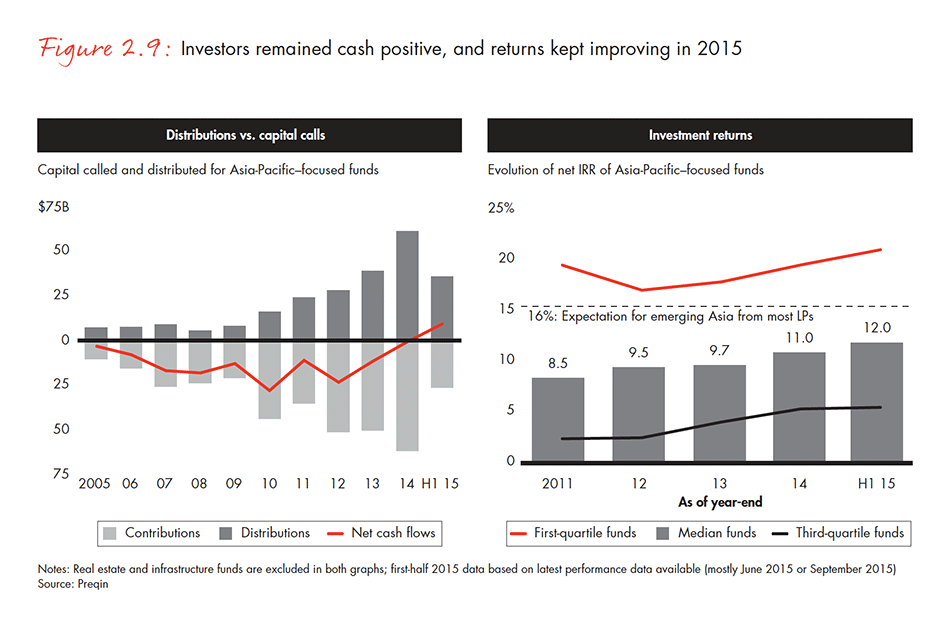
Continued strength. Critically, these distributions come with improving returns—especially among the top-quartile funds that attract the most investor attention. Median returns for Asia-Pacific–focused funds pushed toward a 12% net internal rate of return (IRR) based on the latest data available (mostly June or September 2015). That’s a 1 percentage point improvement from returns logged in December 2014. Top-quartile funds, meanwhile, posted an average of 21%, well above the 16% net IRR most LPs say they demand from their emerging Asia exposure. While it is hard to accurately assess fund returns in the early years of an investment, we are heartened by the fact that younger Asia-Pacific funds—those in the 2010–2012 vintages—are currently expected to generate returns of more than 16%. That is well above expectations for similar vintages in the US and Europe.
Speed bumps ahead. All that said, it is very likely that returns will come under pressure in 2016 and beyond. Since the projected IRRs for those younger vintages are essentially paper returns, they can change direction very rapidly. PE fund returns typically take about seven years to stabilize, and a lot could happen between now and when investors actually see their money. Slowing GDP growth, chronically high price multiples and interest rates that have nowhere to go but up will only make it harder to produce the IRRs that investors demand of their emerging market exposure. And if the market’s record pile of unrealized capital continues to grow, it will become more and more difficult to make timely distributions. Producing market-beating returns, in other words, will require GPs to squeeze more out of their portfolios with strategies to counteract the market’s headwinds. More on that in Sections 3 and 4.
Fund-raising: Winner take all
This clear call to action is most apparent in the industry’s fund-raising dynamics over the past several years. Although the market remained extremely crowded, with approximately 280 of the market’s 1,400 active funds on the road looking for funds over the course of 2015, capital raised from LPs declined 15%, to $50 billion, on par with the historical average. That compares with a 2% decline globally, to $428 billion (see Figure 2.10). Parsed another way, there were 2.8 times more Asia-Pacific–focused firms on the road in 2015 than those that actually closed their funds. They were seeking $74 billion at the end of 2014 and attracted about two-thirds of that.

The flight to quality continues. Part of the sluggishness was that limited partners are definitely looking to deploy capital elsewhere as they wait for more clarity in the Asia-Pacific region. A recent Preqin fund manager survey identified Asia as the region most shaken in global investor confidence. Nearly a fifth of global fund managers surveyed planned to decrease their investment in the turbulent region.
It would be a mistake, however, to conclude that the softness in fund-raising last year was an indication that LPs have soured on the Asia-Pacific market in any permanent way. A closer look at the numbers suggests two other factors at work. First, GPs focused on the region are already flush with unspent capital, meaning many were simply more intent on putting money to work in 2015 than on raising more. Second—and this is where the call to action comes in—LPs are becoming increasingly more selective when choosing funds with which to invest. LPs have learned their lesson in the Asia-Pacific markets, having been badly disappointed by the region’s performance during the last boom cycle. Longer track records mean they also have better visibility into which funds can be trusted to produce sustained, market-beating performances. The resulting flight to quality is funneling the distribution of fresh capital toward the very best firms—those that have proven they can perform in an increasingly difficult environment.
Top performers are doing fine. This dynamic can be seen through several lenses. For instance, the minority of Asia-Pacific funds that managed to close last year raised an average of 4% more than they targeted vs. a five-year average of negative 4%. They also took less time to close—18 months on average vs. 20 months in 2014. Even among this group, LPs showed a clear preference for the largest, most experienced funds. These GPs, which raised more than $1 billion, took only 12 months to close, and two-thirds of them met their targets. By comparison, only 51% of smaller funds with less experience met their targets, and just 28% of first-time funds did (see Figure 2.11 ).
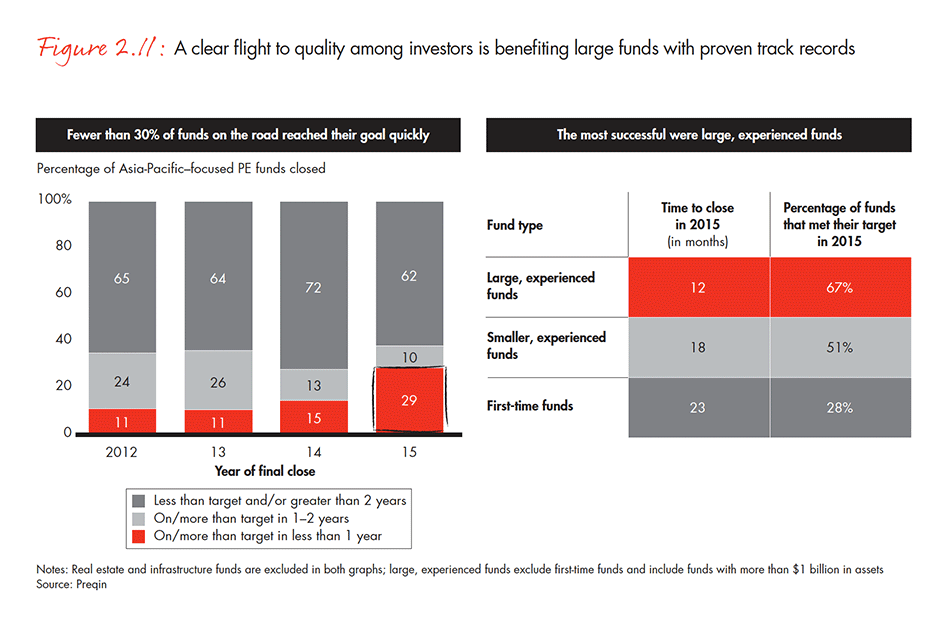
Turning to the family office. Further complicating the fund-raising dynamic is that the composition of the Asia-Pacific region’s PE investor base is changing. In many cases, new regulations are restricting the amount of capital that traditional sources such as pension funds can invest in private equity. At the same time, LPs are cooling on the fund of funds channel, slowing down another stream of capital. Data shows that GPs are increasingly turning to family offices and high-net-worth individuals who have a strong appetite for private equity and large allocations available to invest in alternative asset classes. Sovereign funds and government agencies, meanwhile, continue to be a key source of capital in the region.
These large, sophisticated investors are especially partial to GPs with a clearly differentiated strategy and a record of strong performance. As economic conditions get increasingly challenging, it stands to reason that they will only become more selective.
Megadeals, public to private transactions and the Internet sector drove record performances in the Asia-Pacific private equity industry last year. But there are many challenges ahead in the shifting market. Suvir Varma, leader of Bain's Asia-Pacific Private Equity practice, discusses three themes that will help investors.
3. Searching for opportunity amid a new normal
Private equity investing in the Asia-Pacific region has always centered on growth. Powered by legions of rising middle-class consumers, this diverse collection of vibrant emerging economies has historically grown at a significantly faster pace than the rest of the world. The great preponderance of PE deals in the region have relied on growth strategies aimed mostly at increasing a company’s topline—creating value by riding an industry tailwind, for instance, or expanding geographically and adding new markets. Even in the wake of the global economic crisis in 2008, the Asia-Pacific growth story endured. Since then, LPs have allocated $364 billion of fresh capital to funds that are fully dedicated to the region. The number climbs to $1.1 trillion when you include funds with some Asia-Pacific focus.
So, has the sudden and sharp deceleration of China’s GDP growth over the past year called that growth story into question? To some degree, we think this widespread concern is overblown.
Taken together, the Asia-Pacific economies still offer real GDP growth in the 4% range, well above the global average. Most economists believe that India alone will continue to expand at 7% annually. With markets as diverse as Japan and Myanmar, economic and investment prospects vary widely. But the Asia-Pacific region is hardly fading as an attractive place to put the private equity value proposition to work. On the contrary, we believe that the region will continue to offer ample opportunity to earn strong returns at an acceptable level of risk to investors looking for emerging market exposure.
What is changing, however, is the shape of those opportunities. China remains the region’s center of gravity and by far the biggest market for private equity. We believe that the profound shifts taking place there are ushering in a new normal in which Asia-Pacific PE investors can no longer rely upon uninterrupted growth. At the same time, asset prices throughout the region remain stubbornly high as record amounts of dry powder pressure GPs to do deals amid stiff competition from cash-rich corporations seeking to buy growth to meet shareholder expectations. Steep multiples may make it difficult to produce adequate returns, given the clouds ahead. This blend of deep economic uncertainty and fierce competition means that GPs will have to work harder across every link in the PE value chain to find attractive companies, increase their value and sell them at a premium.
In this section, we’ll explore the market contours of the region’s new normal and discuss in more detail how GPs are trying to position themselves to win. As last year’s record-breaking deal activity demonstrated, the PE industry can be extremely resourceful when it comes to putting money to work in a difficult environment. The question is this: What do GPs and their investors have to do differently now that the steady tailwind of economic growth can no longer be taken for granted?
The situation in China
Nowhere is this question more pressing than in China, where the massive sell-off on the Shanghai market reflects deep anxiety about the government’s ability to manage its transition from export-led hypergrowth to a more sustainable model fueled by consumption. Most economists agree that China’s real GDP growth rate is on a steady slope downward from about 7% in 2016 to 5% or 6% by the end of the decade (see Figure 3.1). The economy is also littered with potential landmines: Decades of overinvestment have left rampant overcapacity, and some analysts estimate that China’s poorly regulated banking system is sitting on as much as $5 trillion in bad debt— the simmering residue of the nation’s unchecked lending to fuel growth.
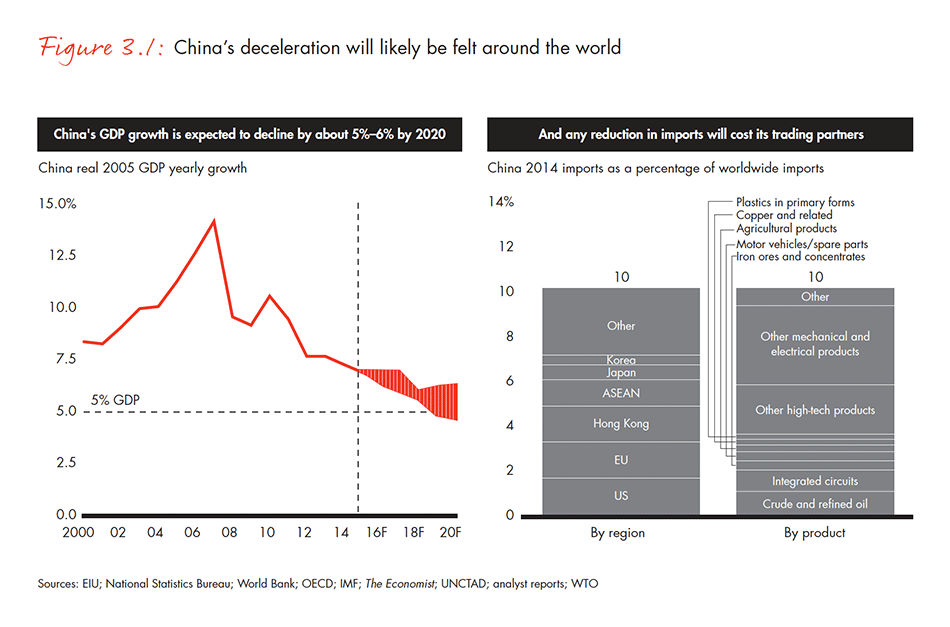
Riding a rocky transition. The threat of a financial meltdown has limited the government’s ability to institute reforms that would increase consumer spending and speed the transition to future sources of growth. Instead, Beijing is faced with the growing challenge of cleaning up the financial system without pitching the economy into recession. Given that China buys more than $2 trillion of goods and services globally each year, the spillover effects from its slowdown will likely be felt around the world, with pressure on global trade, commodity prices, currencies and lending.
Against this backdrop, 2015’s record-breaking $69 billion in PE deal value was truly remarkable. The total, which was 56% higher than the previous peak, owed much to a strong crop of $1 billion-plus megadeals—14 of them, vs. 7 in 2014. But the individual deal count also rose sharply to 488, or 54% higher than the previous five-year average. This surge in activity was a tribute to both the motivating power of the market’s massive pile of dry powder and the industry’s ability take full advantage of what the turbulent market had to offer. As clouds gathered over traditional industries such as manufacturing and retail, for instance, investors poured into the red-hot Internet sector, which showed no signs of stalling. Faced with rising multiples that made traditional PE deals too expensive, GPs pivoted to Chinese companies that were undervalued on US exchanges, leading to a number of massive public-to-private deals. As we’ll explore later in this section, the best GPs were also able to work closely with large cohorts of GPs and LPs to coinvest in a number of deals that would have been too large to handle alone.
A test for PE. As China’s economy continues to sink into uncertainty, it will test the industry’s resilience and creativity. Few doubt that returns will come under pressure as GPs confront challenges from all directions. Anemic growth in many sectors means that the average company’s profits are likely to weaken substantially. That and sinking public equity values may ease pressure on price multiples in some sectors, but they will also cloud visibility into the future, making it difficult to assess (and create) real value. Hot sectors such as the Internet, meanwhile, are hypercompetitive, meaning multiples are soaring through the roof. That presents a growing bubble risk and makes it difficult to buy with discipline.
All of this will challenge GPs’ ability to put massive amounts of dry powder to work profitably. And the exit environment won’t be any easier. Despite two years of strong exit activity in China, the backlog of unrealized value is likely to rise in the years ahead, given increasing pressure on portfolio company earnings, a weakening IPO channel and the likelihood that potential corporate buyers will turn inward to focus on defending their core operations or invest elsewhere.
Capital outflow. One final note regarding China’s impact on the global PE market: As we’ve already mentioned, China’s economy is so large and so central to the global economic fabric that its slowdown will surely be felt around the world. But there are two other impacts that will affect PE investors. First, as LPs wait for clarity in China, they will likely direct capital allocations elsewhere. Second, outbound M&A is soaring in China as large domestic companies look aggressively for diversification and market entry elsewhere around the world. Both of these factors are creating an investment capital outflow that is already increasing competition for deals in more stable and attractive PE markets. In the Asia-Pacific region, activity in India or Southeast Asia may benefit from this capital reallocation. But GPs there can also expect competition for deals from cash-rich Chinese corporate buyers eyeing opportunities in their markets.
Asset class and geographic diversification gain steam
As volatility and competition mount across the region, we are seeing an increasing number of GPs seeking to diversify their risk by expanding the scope of their investments (see Figure 3.2). A trend toward geographic expansion has been building for several years as firms try to limit their exposure to any single Asia-Pacific market. Increasingly, they are also taking steps to add new asset classes—setting up hedge funds, for instance, or investing in nontraditional areas such as debt instruments, real estate and infrastructure.

As appealing as diversification might seem in an increasingly challenging environment, however, it can also pose a high degree of risk. Asset class expansion, in particular, typically offers few operational synergies and can dilute focus at a time when staying on point is critical.
Increasing appetite. About a third of the GPs in our survey said they invest in nontraditional asset classes, and 45% of them indicated they would be broadening their scope to include such investments over the next five years. One prime example emerged in January 2016, when KKR said it had formed a partnership with China Orient Asset Management and COS-Capital to focus on credit and distressed debt opportunities in China, with a key focus on the real estate sector.
Around 11% of respondents, meanwhile, said that they plan to increase their geographic scope over the next five years. Indonesia’s Northstar, for instance, has broadened its area of activity to cover other countries in Southeast Asia, while Vogo in South Korea recently recast itself as a pan-Asia fund. Many GPs are also doing cross-border deals (defined as investments placed in geographies where the firm has no on-the-ground presence). A good example is TPG’s India team, which led a $53 million investment in Sri Lanka’s Asiri Hospital. China’s GSR Ventures recently raised a $5 billion fund to invest globally in companies focused on accessing China’s market.
Size and experience matter. Aside from straight portfolio diversification, there are many reasons why firms choose to widen their scope. The move may be opportunistic—a way to tap an area of high growth or capture short-term returns. It may be a way to leverage a marquee brand name in fund-raising or to meet customer needs. Many believe that lucrative synergies can be found between old and new areas of focus. Sometimes there is also an organizational rationale—namely, diversification provides opportunities for teams to branch out beyond buyouts and growth deals.
In our experience, however, these decisions to steer significant capital and resources away from a firm’s core strategy should be made very carefully. A few large global firms such as Blackstone have made it look easy by using diversification to build scale and spur growth. But few PE firms have the talent and expertise to expand into unfamiliar territory successfully. Most GPs, especially those already pressed to source deals and engineer exits in their core business, are better served to focus on executing closer to the firm’s sweet spot and creating differentiation rooted in existing capabilities.
Branching out wisely. Between the two, geographic expansion is probably less risky. The synergies are clearer when a firm invests in a market outside its geographic scope since it can take advantage of existing capabilities and sector expertise. Done well, it is basically an adjacency play that takes advantage of a firm’s core strength and repeatable model to tap new geographies and limit market concentration.
But simply parachuting a team into another country rarely achieves the desired result. Successfully expanding beyond a sweet spot requires a clear evaluation of the opportunity and a robust strategy to compete and differentiate in the new market. There are many models for entering new geographies, but some are better than others. In our experience, the best approach relies on a mix of organic and inorganic expansion, blending the firm’s expertise with the right local hires to fill in the critical local knowledge and networks. Carlyle, for instance, has gone to great lengths to build local contacts since it began expanding its footprint in the region in the late 1990s. Central to its strategy has been a board of prominent Asian officials and business people assembled by former US President and Carlyle adviser George H.W. Bush. This group helps open doors and find investments. But each Carlyle office also needs a well-rounded team of professionals on the ground to put capital to work profitably.
Coinvesting with limited partners
Large, well-connected GPs are also finding opportunities to invest in some of the biggest deals by teaming up with SWFs and other large institutions that are increasingly seeking novel ways to partner with their favorite GPs on better terms. Often this means coinvesting with one or a select group of GPs (see Figure 3.3), but it can also mean setting up a separate account—that is, an agreement under which a GP invests a pool of capital for a single LP under special terms. Select LPs are also building internal teams to invest directly in transactions sourced by them or partner GPs, but this remains limited to the few large institutions that have enough muscle to take on direct investment.
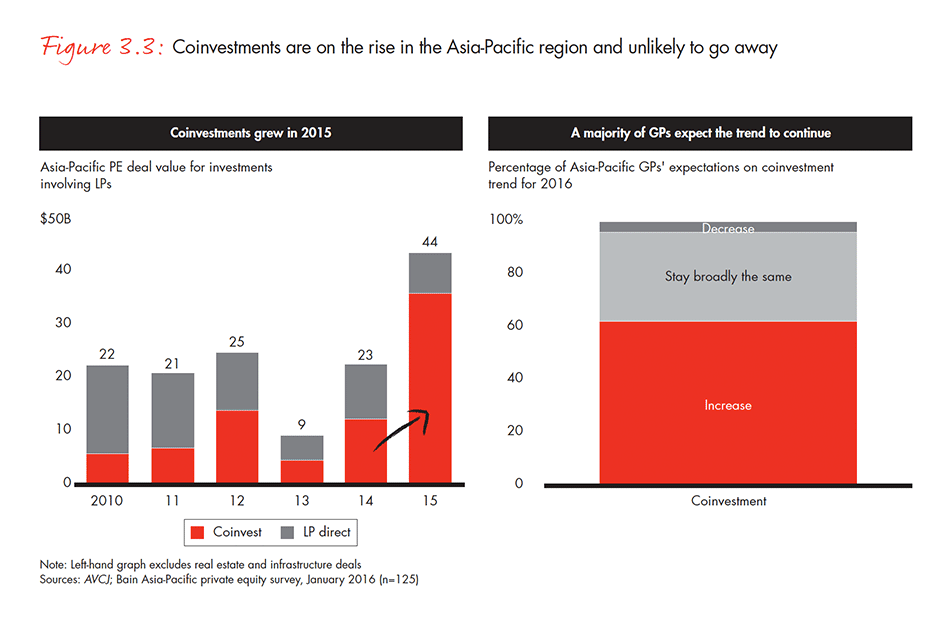
Shadow capital. Commonly referred to as shadow capital, these forms of LP investment proliferate in the Asia-Pacific region and spawned some of 2015’s biggest deals. Out of the 22 $1 billion-plus transactions in the region last year, 12 were either coinvestments involving LPs or deals that included direct LP investments. Coinvestments alone accounted for $36 billion in deal value vs. an average of $9 billion annually over the previous five years. Separate accounts, which are gaining in popularity globally, have yet to become as big a factor in the Asia-Pacific region, but momentum is building. GPs have raised more than $2 billion in separate accounts over the past two years. One example: The Reserve Bank of India last year placed $157 million with SIDBI Venture Capital to form the Reserve Bank start-up fund.
LPs have gravitated toward more direct investment for several reasons. The most obvious is that direct investment can produce better returns since LPs tend to enjoy better fee structures in coinvestments and structured accounts. These arrangements give LPs more control over outcomes, premium access to the best GPs and the chance to enhance their internal investment management capabilities. But they also generate controversy. Because shadow capital isn’t counted in fund-raising totals, it is hard for other investors to know exactly what influence a side arrangement with an unnamed large investor may be having on a GP’s behavior. Some observers also see LPs looming as competition in a crowded market for attractive deals.
More opportunity than threat. In our survey, only 11% of respondents viewed large institutions or SWFs as a threat. Most recognize that shadow capital tends to expand the pie, not claim an undue share of it. In practice, the presence of large, well-connected investors in the market allows an elite group of GPs to take on bigger deals than they would otherwise be able to do. And because SWFs have unique relationships with government entities, they also get access to deals in the Asia-Pacific region that would never be available to others. For many GPs, coinvestments and separate accounts burnish relationships with important, deep-pocketed investors. That can be a welcome sweetener in a tough Asia-Pacific fund-raising market.
One thing that’s clear about shadow capital is that it’s not going away. SWFs have long been major players on the Asia-Pacific PE scene, and other large institutions see strong reasons to keep allocating a portion of their capital to a more direct form of PE investment. Among the GPs in our survey, 62% said that they expect coinvestments to increase in 2016. For most of them, the spread of shadow capital is less a threat than an opportunity to participate in some of the region’s biggest, most important transactions.
The need to exert control
As appealing as diversification or coinvestment may be, the key to thriving amid slower growth and turbulence for most PE firms will be shoring up their core value proposition. As we’ve said, the region’s rising tide of steady economic growth in years past tended to lift all boats and propel even average companies to higher valuations. As growth ebbs, however, it will become proportionally harder to create value without making significant changes to a portfolio company’s operations, management team and strategy. The power to exert such influence has often been missing in the Asia-Pacific region—especially in the minority deal situations that have tended to dominate the region’s PE investing activity. But that is changing as GPs increasingly gravitate toward transactions that offer significantly more control over investment outcomes.
A shift to buyouts. To some degree this is a natural outgrowth of the Asia-Pacific PE industry’s maturation. Company sellers once wary of giving up too much equity have warmed up to the PE value proposition. GPs say that owners appreciate the expertise and capabilities that GPs can offer and are more often willing to give investors bigger stakes, board seats and decision rights that firms can use to exert real influence over value creation.
The trend toward more control produced a surge in buyout deals in 2015, and that’s likely to continue (see Figure 3.4). Value in these transactions (which feature a majority stake) jumped to $53 billion, dwarfing the $22 billion average over the previous five years. According to Bain’s 2016 survey, 75% of GPs said that they expect buyouts will make up more than 80% of their portfolios over the next two or three years vs. 50% for growth deals. They also expressed their intent to negotiate path-to-control provisions even when they do sign growth deals with minority stakes. At the moment, 39% of portfolio companies bought with minority stakes are protected by such provisions, but GPs expect that proportion to grow to more than 48% in the next two to three years.
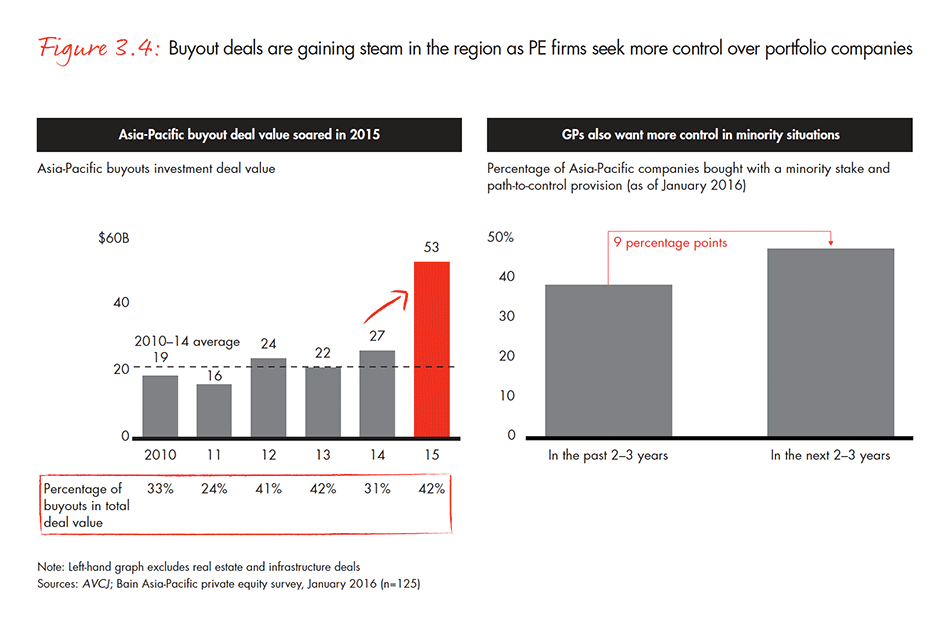
Execution is critical. As necessary as such control mechanisms are when it comes to generating better returns, they aren’t sufficient. It’s also critical that GPs make the most of the opportunity to directly improve a company’s performance—something many GPs worry they don’t do well enough (see Figure 3.5). Although 58% of the GPs in our survey said they put in place robust value creation plans for 80% of their portfolio companies within six months of an acquisition, only 14% said they believe that they are executing successfully on those plans. The median fund has two to three full-time people per geography devoted to value creation and plans to add at least two more by the end of the decade. But it’s not clear whether this increased investment is paying off in better results.

We’ve devoted Section 4 to examining this issue in more depth, but we believe that the answer lies in how PE firms approach portfolio activism. Rather than simply shifting people into value-creation roles, GPs need to ask themselves whether those people have the right skills and experience to derive real value in a market that is becoming decidedly more challenging. As we’ve noted, with so many companies selling for sky-high multiples and exit channels becoming significantly less friendly, returns are likely to come under pressure in the Asia-Pacific region. Five years ago, almost 70% of the GPs we surveyed said that improving topline organic growth was their main source of value creation. In today’s environment, more than half say they will rely on M&A and improved capital efficiency as the two main sources of value creation over the next five years. Consequently, it will become increasingly important to bring in new talent with expertise in change management, transformation and margin improvement.
Sector opportunities amid macro changes
Overall macro volatility will certainly affect the short- and medium-term investment outlook for the entire Asia-Pacific region. It has already cast a pall over many of the traditional industries and consumer markets that investors have favored in recent decades. But longer term, the world’s center of gravity is clearly shifting back toward the Asia-Pacific region, laying a firm foundation for future growth. By 2025, the region will be home to a staggering 4 billion people—four times as many as in North America and Europe combined. Their lives will be fundamentally different than they are now, with important demographic shifts ushering in new spending patterns and behaviors.
These markets are becoming older, wealthier and technically more sophisticated. The region is learning to produce more for domestic consumption, and exports increasingly consist of higher-value goods. Over time, this combination promises to rekindle substantial growth, and forward-looking PE investors are already staking out claims in those sectors likely to benefit. The list that follows is hardly exhaustive, but it does give a sense of where investors are looking next as the Asia-Pacific region matures (see Figure 3.6).
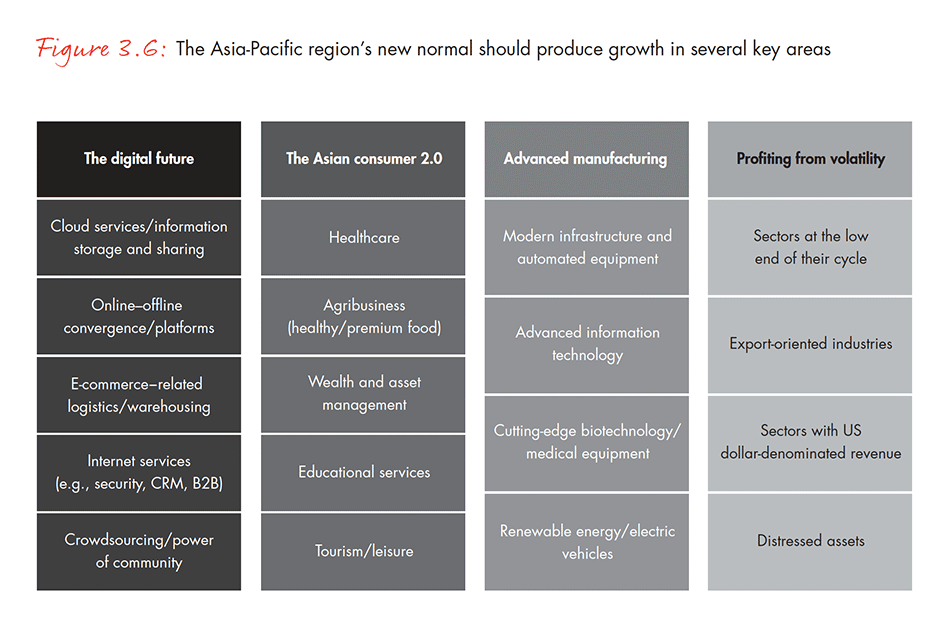
The digital future. As we’ve mentioned, Internet-related investments dominated deal count and value in 2015 as investors flocked to the one sector that seemed immune to economic pressure. The resulting spike in deal multiples should raise red flags for any investor hoping to join the party in 2016. But there is also good reason to believe that digital technology will continue to reshape people’s lives globally and create ongoing opportunities for investors.
The digital transformation of the consumer experience that many take for granted in developed markets is still gaining steam in many Asia-Pacific economies. Not only is it creating sweeping change in many consumer and B2B industries but innovations such as cloud services and near-zero-cost connectivity are enabling companies with limited resources to harness capabilities that can match (or beat) those of much larger rivals, accelerating penetration of many categories. That has led to large investments in a variety of sectors and geographies. For example, Coatue Management, Tiger Global Management, SoftBank and others pooled $350 million to invest in GrabTaxi, a taxi booking app developer in Southeast Asia. In China, Silver Lake Asia led a consortium that invested $500 million in Qunar.com, which aggregates searches from more than 300 Chinese language travel sites to provide real-time pricing for more than 20 airlines and 10,000 hotels serving the mainland market.
The Asian consumer 2.0. For decades, investors have viewed the Asia-Pacific consumer market through two very different lenses. One has focused on the ultra-wealthy upper classes with their endless appetite for luxury foreign imports. The other has been trained on the emerging consumers at the lowest rung of the middle class who need basic items such as soap, packaged goods and cheap consumer electronics. As the gap closes between these two groups, however, the Asia-Pacific region is producing a new breed of more sophisticated middle-class consumers with life concerns that will sound familiar to families in developed markets. They need better healthcare; safer, more nutritious food; high-quality educational services; and reliable financial services.
Viewed through this lens, a variety of sectors produced fresh opportunities in 2015. Bain Capital, for example, invested $423 million to acquire Ooedo-Onsen-Monogatari, the Japan-based spa hotel company, to tap into the region’s growing appetite for healthy spa resorts. A consortium of Goldstone Investment, Hony Capital, SAIC Capital and Shanghai Pudong Science and Technology invested $1.2 billion in Shanghai Bright Dairy & Food, which has targeted consumers looking for a vendor of healthy dairy products. Other large investments included a $489 million deal for India’s Sun Pharmaceutical Industries and a $230 million investment in Bodyfriend, a Korean manufacturer of massage chairs and related equipment. These companies aren’t focused on either the very rich or the lower middle class. They exist to serve the more complex and nuanced requirements of an increasingly wealthy and educated domestic Asian consumer.
Advanced manufacturing. Led by China and India, the bold vision of most advanced Asia-Pacific economies is to graduate beyond the region’s legacy of low-cost manufacturing and me-too product offerings to create modern, high-tech industrial sectors to rival those in developed markets. Perhaps the most comprehensive expression of this ambition is the “Made in China 2025” initiative introduced by Chinese officials last year. China’s tax and investment policy has long focused on incentivizing industry to use innovation to climb up the value chain to compete in more technologically advanced industries. Made in China 2025 focuses on helping companies become world class across the entire production process in 10 key sectors: advanced information technology, automated machine tools and robotics, aerospace and aeronautical equipment, high-tech shipping, modern rail systems, new-energy vehicles, power equipment, agricultural equipment, new materials, and biopharma/advanced medical equipment.
The Chinese government is also stepping up support for these sectors. A government-sponsored vehicle called the Shanghai Integrated Circuit Investment Fund, for instance, has announced plans to invest about $3 billion in three Shanghai-based chipmakers, with a quarter going to Semiconductor Manufacturing International Corporation, China’s largest and most advanced semiconductor foundry.
Looking more broadly at the Asia-Pacific region, many PE funds have bet on the increased demand for green energy. A good example is the consortium of ADIA, Goldman Sachs and Global Environment Fund, which invested about $700 million in ReNew Power over the past few years, including $265 million in 2015, hoping to participate in the growing demand for renewable energy in India.
Profiting from volatility. As with any period of cyclical weakness and volatility, the current environment is presenting opportunities for sophisticated contrarians. The gloomy global growth outlook, sinking oil and commodity prices, erratic currencies and potential upward movement on interest rates are all attracting the attention of value-hungry investors. Hony Capital, for instance, last November invested $355 million in Santos, a major Australian oil and gas company. EMR Capital and Farallon Capital anted up $775 million to acquire PT Agincourt Resources, the Indonesia gold and silver mining group. The eroding credit environment is presenting opportunities for distressed investment/special situation specialists. KKR, for one, has overweighted its portfolios toward distressed investments partly because it believes that China’s structural investment slowdown is creating distressed opportunities in that country’s overleveraged corporate sector. KKR also sees a knock-on effect among China’s trading partners in emerging markets, especially India and Indonesia.
There’s no doubt that investors with a clear understanding of a specific market can do well playing cycles amid heavy volatility, but it remains a highly risky strategy in most cases. Making it work usually requires bringing to bear other mechanisms to create value by improving performance and assessing risk. Success requires exquisite timing both at purchase and at exit.
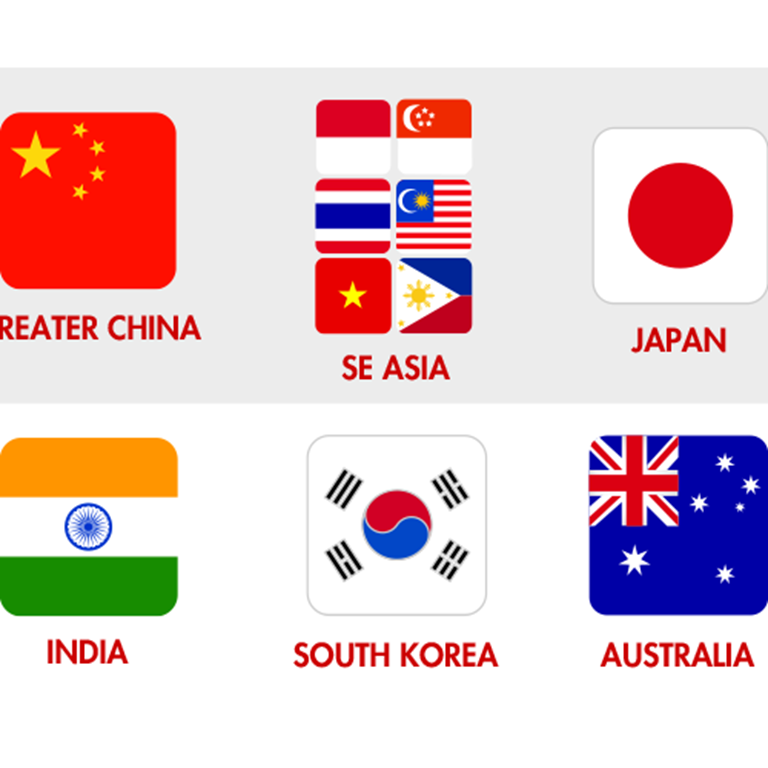
Private Equity in Asia-Pacific: Diverse markets, different outlooks
A look at the private equity highlights from 2015 and the outlook going forward in Greater China, India, Southeast Asia, South Korea, Japan, and Australia.
4. Thriving in turbulence and uncertainty
One of the primary reasons private equity has such enduring appeal among large, sophisticated investors is that it tends to outperform other asset classes, especially in times of turbulence. In the Asia-Pacific region, for instance, investment advisory firm Cambridge Associates found that buyout funds outperformed public markets by five to seven percentage points over both one-year and five-year-plus time horizons. Even funds closed during the global financial crisis have fared well. The median IRR of the Asia-Pacific funds from the 2006 to 2008 vintages initially sank to a negative 1.7% by December 2009. But with the fullness of time, those paper losses turned into gains and grew to around 10% by June 2015. That’s lower than the 12% median IRR across all vintages as of the same date, but still robust given the magnitude of the downturn (see Figure 4.1).
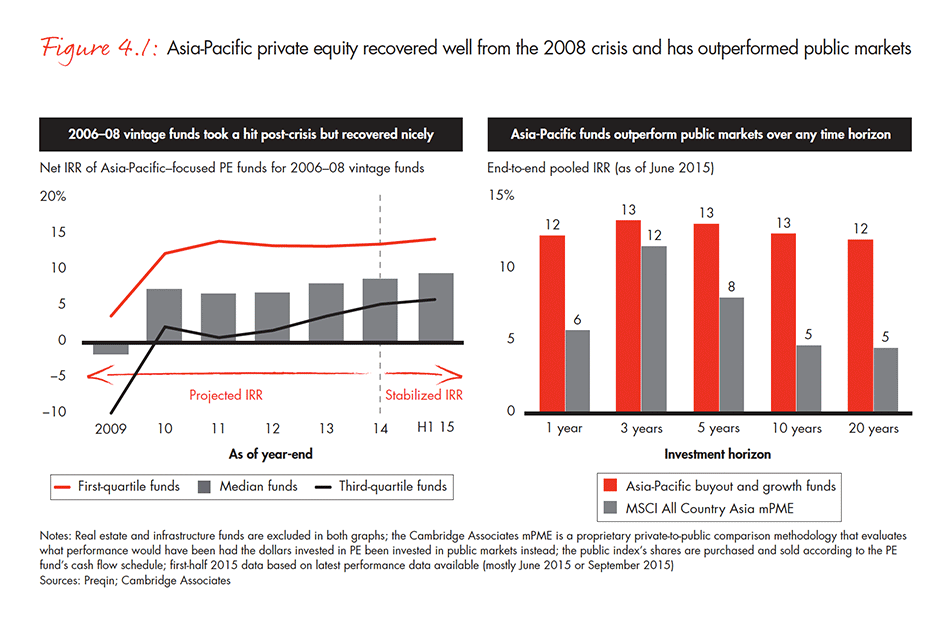
The PE advantage. The PE value proposition is well tuned for hard times because it allows GPs to actively manage assets as conditions change. Firms can tap internal capabilities or hire new talent to transform portfolio companies in a variety of ways, from reshaping operations to restructuring balance sheets. It’s also an advantage that capital is stable and the investment horizon is extensible, at least to a degree. In times of crisis or turbulence, that can often allow enough time before exit to produce meaningful changes to the business and adapt to a new competitive or economic context if necessary.
Why review all of this? Because at a time when soaring deal multiples and slowing growth threaten to disrupt exits and returns, it provides important context around what GPs should be doing to prepare. The best PE firms manage their way through volatility by sourcing well, understanding risk, adding value during holding periods and setting themselves up to exit opportunistically. But they also have to be able to pivot when conditions change. Carlyle Group provided a textbook example of doing this well in 2007, when it spent $80 million on a 49% stake in China’s Yangzhou Chengde Steel Tube Company. The Carlyle team believed that Yangzhou could become a strong global player given its low cost structure, competitive product quality and short production lead time. But when the financial crisis hit with full force a few months later, the game plan changed. Carlyle weathered the storm by aggressively managing working capital and curtailing spending to preserve cash. It also replaced management, improved governance and invested heavily to triple capacity, modernize production and shift to higher-margin products. By 2010 when the economy began to recover, Carlyle had built a solid exit story, allowing it to sell its stake to Precision Castparts, a US-based strategic buyer, for three times its original investment.
Coping with uncertainty. There’s no way of knowing how long the fog of uncertainty will hang over the Asia-Pacific region or how it will ultimately affect market conditions. But for all the reasons we’ve outlined above, it is highly likely that returns will be challenged as exit channels come under pressure and GPs hold companies longer. It would be easy to look back over the past two years of robust deal and exit activity and assume that what worked in the past will work in the future. But we find the most successful GPs are never that complacent. Changing conditions prompt them to recalibrate their Repeatable Models® for a new set of competitive and market assumptions. In the current environment, they are focusing on three key areas (see Figure 4.2).

Creating a stormproof portfolio
As macro and industry conditions change, so do the assumptions underpinning most deal theses. It becomes critical to size up each company in a portfolio by asking two things: Does the original investment thesis still hold water? And if not, what must be done to maximize value in a new, more difficult environment? This is essentially a repeat of the due diligence process through the lens of economic disruption. It involves reevaluating the risks emerging from the new macro environment, gaining a fresh understanding of the company’s sensitivities to those risks and realigning the value-creation plan to thrive in this new normal.
The next step is to prioritize where the firm will spend its limited resources. It’s often tempting for PE firms to overinvest in losing deals as they try to steer the company back on track. But thriving in turbulence requires firms to adhere to a simple principle: Double down on the winners and minimize your losses. Where a company ranks along this spectrum is a function of how much equity is at risk and how much investment is required to drive an adequate level of value. In our experience, firms need to adopt a disciplined, systematic approach to drawing these priorities if they want to avoid the impulse to throw good money after bad.
That said, the strength of private equity is that it is patient capital. Firms too often trip up by overreacting to short-term volatility and lose faith in the fundamentals that attracted them to the company in the first place. Once it becomes clear which companies should get the most attention, it is time to go to work to bring those fundamentals to full potential. If conditions have deteriorated rapidly, these companies might need a short-term strategy to help them ride out the storm—raising cash through balance sheet adjustments or selective cost cutting, for instance, combined with plans to enhance revenue right away. This will give the firm and management time to thoughtfully adjust the longer-term value-creation plan, refocusing management attention by tying incentives to executing on the top three to five initiatives that will truly make a difference.
The GPs that find the most opportune exits amid difficult conditions typically aren’t the beneficiaries of good timing or fortune. They have been preparing the company for exit almost from day one so that they can seize the best opportunity when it arrives. They identify potential buyers early, decide on the most likely timetable for exit and tailor their value-creation plan accordingly. In effect, they put themselves in a potential buyer’s shoes and ask what set of value-creation strategies will build the most compelling exit story. Then, when the exit horizon draws near, the firm is ready to optimize in-year EBITDA and cash flow to present buyers with the most attractive asset possible.
Sourcing from a position of strength
With huge piles of unspent capital waiting to be put to work, GPs in the Asia-Pacific region are under heavy pressure to find deals and close them. But as rising asset prices collide with slowing economic growth, it is especially critical to approach the market with discipline. We find that the most effective GPs have internalized a set of capabilities that allow them to walk the line between taking appropriate risks and paying too much for assets. As macro conditions become more challenging, successful GPs become more focused on their sweet spot and concentrate on the fundamentals they understand and believe in most. That gives them the confidence to go deep on fewer companies and build a thesis that allows them to outbid others from a position of greater knowledge and insight. They assess opportunities for what they really are, not what either wishful thinking or excessive pessimism make them appear to be.
Macro uncertainty also means that GPs need to push harder on downside scenarios to develop a clear understanding of what would happen to a company’s value if the worst were to occur. Very often this requires an honest reassessment of existing capabilities. How well, for instance, does the firm really understand the interplay of macroeconomic and microeconomic factors that affect its portfolios? Few anticipated the black swan plunge in oil prices over the past year. But the GPs that have avoided the most pain are those that understood in advance how such an event would affect their companies and were prepared to pull the right levers when the moment came to act.
Most often, however, finding the right opportunities as economic growth slows means reorienting the firm’s thinking around what will create value in the new environment. As we’ve noted, many portfolios in the Asia-Pacific region have benefited historically from strong tailwinds that propelled organic revenue growth. Without that macro support, premium value will more often come from performance improvement. That might mean ferreting out ways to zero-budget aspects of production or the supply chain to find efficiencies that boost margins. It could involve expanding the topline via M&A or adding capabilities to take advantage of an untapped market adjacency. Cost reduction is rarely enough to produce a winner on its own. But combining margin improvement with revenue expansion can be a powerful way to counteract economic malaise.
As we pointed out in Section 3, it can also make a big difference to scout deals in key sectors where growth is likely to hold up even as macro conditions deteriorate. Our view is that GPs need to be disciplined in such situations—it can be perilous to drift too far from the firm’s sweet spot in pursuit of seemingly attractive sectors. But firms with a clear understanding of industry dynamics and a strong deal thesis can find value and growth amid even the worst conditions. A good example is Sequoia Capital’s $23 million investment in India’s Prizm Payment Services, with $15 million committed in 2008. Prizm deploys and operates point-of-sale and ATM-based payment systems for banks and financial services companies. Convinced that there was a gap between the demand and supply of ATMs and sensing the potential to substantially increase the company’s footprint, Sequoia’s team decided to back Prizm, which was perfectly positioned to take advantage of the growing use of debit and credit cards in India. Amid a global financial crisis, Sequoia provided capital and expertise to help make it happen and focused early on crafting a clear exit strategy. When Japan’s Hitachi came looking for an entry to India’s burgeoning financial services market in 2013, it latched onto Prizm, offering a multiple of five times Sequoia’s initial investment.
Building a battle-ready organization
What we’ve been talking about in the previous two sections is portfolio activism—the need for PE firms to create their own tailwind instead of relying on economic expansion to propel returns. Most of the GPs we surveyed recognize the growing importance of adding heft in this area. Today, 41% of the GPs in our survey use an internal team to manage post-acquisition value creation for almost all their companies, and more than half said they would do so over the next three to five years. Moreover, 55% employ external help for more than half their companies, and that number should grow to 73% in the coming years. As we noted, however, strong execution is another matter: Only a small minority of firms believe that they execute as planned on value creation. Most often, in other words, the resources put in place to boost value aren’t doing the job.
There is no right model for improving the firm’s ability to execute more consistently. But all successful efforts begin with attracting, retaining and nurturing top talent to drive the effort forward. That requires doubling down on efforts to identify, elevate and retain star talent both within the firm and at portfolio companies. But it also means assessing what skills will be needed to thrive in the new normal and building those capabilities either internally or by tapping specialized external resources.
Transforming companies to thrive in a more difficult environment, for instance, may require procurement specialists to rework the sourcing strategy or experts in salesforce effectiveness who can put in systems to boost the topline. CVC Capital Partners has addressed this issue by creating an operations team to work with existing deal and capital markets teams to set up a structured value-creation approach within its portfolio companies. Other firms have achieved a similar result by using a mix of inside and outside resources.
In our experience, PE funds also have to look at how they make decisions, starting with the investment committee (IC). Too often, the firm lacks a full understanding of how macro and competitive dynamics will affect portfolio companies. They need to assess whether they have the proper processes in place to bring the people with key knowledge and insights into decisions. They should ask whether the committee is meeting often enough and using the right data to assess performance. Once investments are made, the IC needs stringent guidelines to ensure that the firm is allocating resources to the portfolio companies with the highest potential to produce market-beating returns.
The best GPs take a forensic approach to their past investments to diagnose what led to success and what produced failure. They can then build decision tools based on those factors to force deal teams to assess how prospective acquisitions stack up. They also use this knowledge to create proprietary performance metrics to help track portfolio companies and provide early warning signs before an investment veers too far off course. The result is that the firm can take a proactive approach to value creation, confident that deal teams have a solid handle on the risks and opportunities ahead. The objective is to dial up the firm’s intelligence and market radar to ensure more consistent market-beating results.
5. Are your value-creation capabilities tuned for a new normal?
A year ago in this space we made the observation that the most successful PE firms around the world share a key trait: They quickly transition from thinking as acquirers to acting as value creators. As Asia-Pacific growth slows, this has never been a more essential attribute. In fact, we would argue that the best acquirers in many ways are value creators. The clarity of their insights, the quality of their due diligence and the discipline with which they price assets all represent the initial steps in mobilizing the right value-creation strategy and executing on it. As we did last year, we’d like to end this report with a set of questions designed to help firms that are preparing for a more challenging future assess where they stand in terms of value-creation capabilities. These questions will also help firms consider how they might adjust their priorities to build more sustainable performance.
Have you stormproofed your portfolio?
- Do you understand how the new normal will affect your current holdings?
- Is there consensus among your deal and operating partners about which portfolio companies have the potential to go from good to great?
- Does your firm back those companies with sufficient resources to help them become big winners?
- Are company management and operating partners aligned on the short list of priority initiatives that will really move the needle on equity value creation?
- Do you have clear exit plans in place to help maximize your returns?
Are you sourcing from a position of strength?
- Do you relentlessly focus on your sweet spot and outbid only on companies with fundamentals that you understand and believe in?
- Do you have a clear understanding of how the sectors you invest in will hold up during a downturn and how those risks will affect your companies?
- Does your due diligence produce clarity on opportunities for incremental growth, margin improvement and downside risks?
Are you building a battle-ready organization?
- Has your firm developed the internal capabilities or a network of specialists that it can call on to help produce margin improvement or turnaround initiatives at portfolio companies?
- Does your investment committee have processes in place to drive more informed, consistent decision making?
- Does your firm have stringent guidelines about how to prioritize time and resources?
- Have you sharpened your HR systems to ensure that you are nurturing your key people and attracting the best talent from outside the firm?
As we’ve stressed throughout this report, there’s little doubt that the Asia-Pacific private equity industry will be challenged to repeat 2015’s performance in the coming years. Yet we’re more than confident that the best firms will adapt and thrive amid slower growth and fierce competition. Over the past several years, PE has proven its value to both company owners in the region and global investors looking for a potent source of superior investment returns. But make no mistake—the market will continue to reward only those firms that can adjust to the Asia-Pacific region’s new normal to produce consistent, market-beating performance.
Market definition
The Asia-Pacific private equity market as defined for this report
Includes
- Investments and exits with announced values of more than $10 million
- Investments and exits completed in the Asia-Pacific region: Greater China (China, Taiwan and Hong Kong), India, Japan, South Korea, Australia, New Zealand, Southeast Asia (Singapore, Indonesia, Malaysia, Thailand, Vietnam, the Philippines, Laos, Cambodia, Brunei and Myanmar) and other countries in the region.
- Investments that have closed and those at the agreement-in-principle or definitive agreement stage
Excludes
- Franchise funding, seed and R&D deals
- Any non-PE, non-VC deals (e.g., M&A, consolidations)
- Real estate and infrastructure (e.g., airport, railroad, highway and street construction; heavy construction; ports and containers; and other transport infrastructure)
Acknowledgments
This report was prepared by Suvir Varma, a Bain & Company partner based in Singapore who leads the firm’s Asia-Pacific Private Equity practice; Madhur Singhal, a partner based in Mumbai and a member of Bain’s India Private Equity practice; and a team led by Johanne Dessard, practice area director of Bain’s Asia-Pacific Private Equity practice.
The authors wish to thank Vinit Bhatia, Michael Thorneman, Weiwen Han, Kiki Yang, Sebastien Lamy, Usman Akhtar, Arpan Sheth, Srivatsan Rajan, Wonpyo Choi, Jim Verbeeten, Simon Henderson and Nic Di Venuto for their contributions; Rahul Singh for his analytic support and research assistance; and Michael Oneal for his editorial support.
We are grateful to Preqin and Asian Venture Capital Journal (AVCJ) for the valuable data that they provided and for their responsiveness.
This work is based on secondary market research, analysis of financial information available or provided to Bain & Company and a range of interviews with industry participants. Bain & Company has not independently verified any such information provided or available to Bain and makes no representation or warranty, express or implied, that such information is accurate or complete. Projected market and financial information, analyses and conclusions contained herein are based on the information described above and on Bain & Company’s judgment, and should not be construed as definitive forecasts or guarantees of future performance or results. The information and analysis herein does not constitute advice of any kind, is not intended to be used for investment purposes, and neither Bain & Company nor any of its subsidiaries or their respective officers, directors, shareholders, employees or agents accept any responsibility or liability with respect to the use of or reliance on any information or analysis contained in this document. This work is copyright Bain & Company and may not be published, transmitted, broadcast, copied, reproduced or reprinted in whole or in part without the explicit written permission of Bain & Company.



















